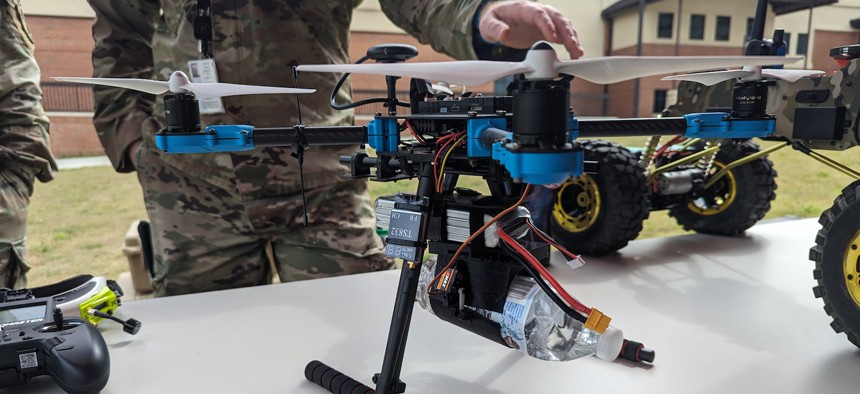
A soldier displays a drone bomber—armed here with a water bottle—at Fort Liberty, North Carolina. Defense One / Sam Skove
Army SOF's new drone course teaches gamer and maker skills
By graduation, the students will know how to build their own drones and teach foreign partners on tactics.
Updated: April 23, 11:32 a.m.
FORT LIBERTY, North Carolina—When Army special operations soldier Josh arrived in Poland to work with Ukrainian soldiers, his students were skeptical of his prowess in flying the high-speed racing drones they use to launch pinpoint strikes on Russian positions.
They said his use of his thumbs rather than index and thumb to control the joysticks was wrong. So he challenged the Ukrainian soldiers to a friendly drone race to find out who was right.
Josh won race after race.
It came down to “a lot of hours [training] in the simulator,” he said, referring to his use of the drone racing video game DRL, which replicates the controls of first-person-view, or FPV, racing drones. Josh is referred to by his first name due to Army Special Operations policy.
He’s now applying the exact lessons he learned while helping Ukraine to a new program that seeks to train Army special operations forces drone operators and prepare them to instruct partner forces on unmanned systems.
The program, dubbed the Robotics and Unmanned Systems Integration Course, or RUSIC, is a six-week course within the Army’s John F. Kennedy Special Warfare Center and School here.
The first two weeks include learning Federal Aviation Administration (FAA) drone regulations and training on program-of-record drones, said Maj. Steve Schuerman, who leads RUSIC and two other training units as a 2nd Special Warfare Training Group company commander.
Week three includes lessons about flying while being jammed by enemy systems, and in using drones in coordination with the Android Team Awareness Kit, an Android-based mission planning tool.
In week four, students learn to operate counter-drone systems, and learn what to do when such systems are unavailable—such as planning routes with enough overhead cover to avoid being spotted.
Week five has students building their own drones and learning to manage battery packs for different payloads, lessons necessary for learning how to advise partner forces.
“It's to teach them the fundamentals so that whatever they [work on] with a partner, they understand how to troubleshoot it,” Schuerman said.
Then, in the final week, students run through an exercise that tests all the skills they’ve learned.
“Students go from never flying a drone to being able to intelligently execute a one-way FPV attack,” said Schuerman.
Students then return to their units, and some have already gone right into advising foreign soldiers about drone usage, he said.
Without these skills, American soldiers risk looking out of touch with modern technology, said Josh, who helps lead the RUSIC program as the non-commissioned officer in charge.
“They're going to come to you with something that looks like this [and say] ‘I need you to fix this’” he said, gesturing to a table of home-made drones while presenting about RUSIC at the Army Special Operations Forces’ yearly capabilities exercise. “If you’ve never seen it before, you look dumb.”
A pilot version of the RUSIC course started in fiscal year 2023, with the first course held in October 2023. There’s been one more course since, and RUSIC intends to run four courses per year, each for 24 students.
Graduates are also certified as master trainers, a designation that allows them to train others, Schuerman said.
That’s particularly important because Army special operations as a whole lacks the master trainers that, per regulation, are the only ones who can train new drone operators. “Within the operating force, there’s very few of these people,” he said.
Besides program-of-record aerial drones, students also learn to operate a variety of commercial drones, build their own FPV drones, and operate ground robots. Josh showed off one ground robot modified to carry an electronic warfare payload.
Ground robots can have a harder time navigating terrain compared to airborne drones, but they are ideal for the tight confines of buildings or for placing other capabilities in remote locations—like electronic warfare devices.
The course does not include loitering munitions due to cost constraints and training facility limitations, Schuerman said.
“I would say our biggest challenge, like everyone else, is resourcing,” he said.
Legal constraints are another factor, Josh said. For training exercises, the off-the-shelf components that the student use to build FPVs must comply with federal acquisition regulation and the National Defense Authorization Act. The U.S. has been leery of foreign-built drones, like those made by Chinese behemoth DJI, because of the risk of data exposure.
In principle, though, Army units should be able to buy any components they want, as drone pieces—such as flight controllers—do not automatically send data back to their manufacturers, Josh said.
“Policy hasn’t caught up,” he said.
The master trainer rule is another stumbling block, he said. A soldier who trained with a master trainer for months on drones but did not receive the master trainer designation could not train anyone else on drones, he said.
Instead, he has advocated for a system more similar to other types of training, where soldiers are allowed to more freely socialize new skills, like medical training.
“I would rather you just say, 'Hey, are you a Green Beret? I’m pretty sure you’re competent to train somebody on a piece of equipment',” he said.
Correction: An earlier version of this article gave the wrong rank for Maj. Schuerman.




